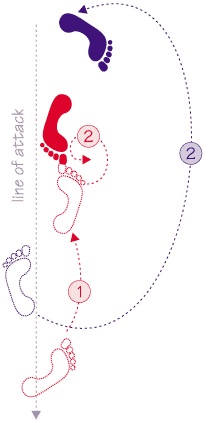Tenkan
Tenkan is a fundamental technique found in the martial art of Aikido. It is often translated as "turning" or "rotation," and involves a practitioner (the nage) redirecting an attacker's (uke's) energy or momentum. This technique is emblematic of Aikido's philosophy of non-aggression, aiming to neutralize conflict without causing harm to the attacker.
Overview[edit | edit source]
Tenkan is executed by the nage stepping to the side and turning in response to an attack, effectively redirecting the uke's forward momentum. This movement can be used to unbalance the attacker, setting up for a variety of throws or joint locks. The precise mechanics of tenkan can vary depending on the specific attack being neutralized, the desired follow-up technique, and the stylistic nuances of the Aikido school or dojo.
Technique[edit | edit source]
The basic steps of tenkan involve the nage moving their front foot to the side, in a motion that is often likened to opening a door. As the nage turns their body, they typically grasp one of the uke's arms or wrists, using this grip to help guide the uke's momentum in a circular path around the nage. The turning motion is completed with the nage facing the same direction as the uke, ideally positioned to apply a subsequent technique.
Applications[edit | edit source]
Tenkan is a versatile technique that can be adapted to counter a wide range of attacks, including strikes, grabs, and punches. It is particularly effective against linear attacks, where the attacker's momentum can be easily redirected. In addition to its defensive applications, tenkan also serves as a foundational movement for many of Aikido's more advanced techniques and combinations.
Philosophy[edit | edit source]
The principle of tenkan reflects Aikido's broader philosophy of harmony and non-resistance. By using the attacker's energy against them, rather than opposing force with force, Aikido practitioners aim to resolve conflicts in a way that minimizes harm. This approach is rooted in the belief that true victory does not come from defeating others, but from avoiding conflict and fostering mutual respect.
Training[edit | edit source]
Training in tenkan, as with other Aikido techniques, typically begins with basic, pre-arranged forms (kata) before progressing to more dynamic and free-form applications (randori). Mastery of tenkan requires not only physical dexterity and coordination but also a deep understanding of timing, distance, and the flow of energy between nage and uke.
See Also[edit | edit source]
Navigation: Wellness - Encyclopedia - Health topics - Disease Index - Drugs - World Directory - Gray's Anatomy - Keto diet - Recipes
Search WikiMD
Ad.Tired of being Overweight? Try W8MD's physician weight loss program.
Semaglutide (Ozempic / Wegovy and Tirzepatide (Mounjaro / Zepbound) available.
Advertise on WikiMD
WikiMD is not a substitute for professional medical advice. See full disclaimer.
Credits:Most images are courtesy of Wikimedia commons, and templates Wikipedia, licensed under CC BY SA or similar.Contributors: Prab R. Tumpati, MD

